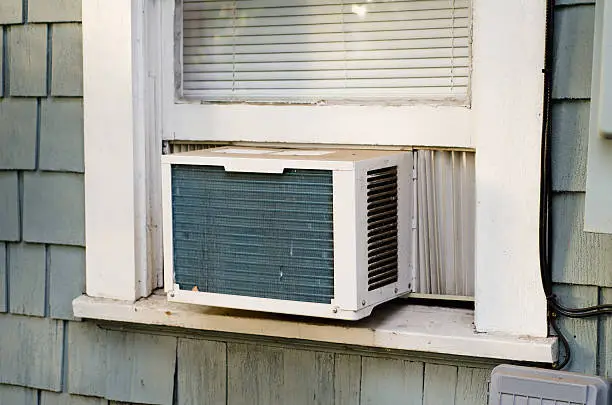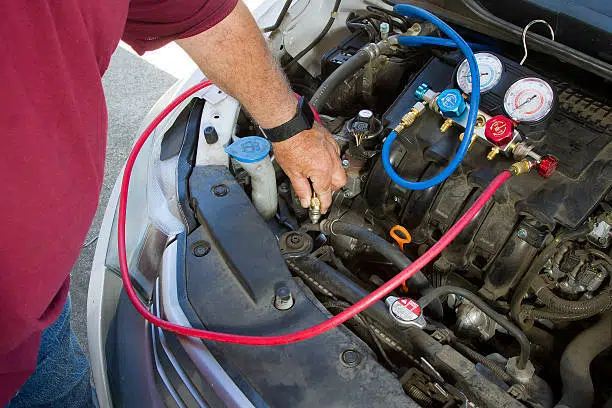
Table of Contents
- Why Casement Window Air Conditioners Are a Great Choice
- Frigidaire FFRS1022R1 – The Powerhouse
- Keystone KSTSW10A – The Budget-Friendly Option
- Koldfront CAC8000W – The Energy Saver
- PerfectAire PASC10 – The Eco-Friendly Choice
- How to Install a Casement Window Air Conditioner
- Why an AC Installation Kit Is Crucial for Casement Window Units
- Why Professional Installation Matters
- Conclusion
- FAQ
If you’ve got narrow windows in your home, finding an air conditioner that fits isn’t always easy. Most window AC units are built for double-hung windows, which means you can be left sweating if all you’ve got are casement or sliding windows. But don’t worry, casement window air conditioners are designed specifically for this type of window, and we’re going to walk you through the top four options available in Canada right now. Plus, we’ll give you a step-by-step guide on how to install them yourself, so you can stay cool without breaking a sweat.
In simple terms, CFM measures the volume of air a fan moves per minute. The higher the CFM, the more air is circulating, and in the world of HVAC, airflow is everything. But why does cubic feet per minute airflow matter to you, and how can you calculate it to ensure your HVAC system is working as efficiently as possible? Let’s break it down.
Why Casement Window Air Conditioners Are a Great Choice
Casement window air conditioners have a slimmer, vertical design that makes them perfect for narrow windows that swing open sideways or slide up and down. Instead of trying to cram a standard window unit into a space it wasn’t built for, these ACs fit snugly and provide the same powerful cooling performance. Plus, they often come with energy-efficient features that’ll keep your electric bill from skyrocketing in the hot summer months.
Now that you know why these units are worth considering, let’s dive into the best models you can get in Canada.
Check out how much it costs to install a new air conditioner in Canada in our previous article.
Frigidaire FFRS1022R1 – The Powerhouse
The Frigidaire FFRS1022R1 is a standout in the casement window AC world. With 10,000 BTUs of cooling power, this unit is perfect for cooling spaces up to 450 square feet, making it ideal for medium-sized rooms like living rooms or large bedrooms. One of the best things about this model is how quiet it is, running at just 48.4 decibels, which means you can keep it on while you watch TV or sleep without it driving you nuts.
This unit also comes with some smart energy-saving features, like a 24-hour programmable timer and sleep mode. You can set it to cool your space just before you get home from work, and it’ll adjust the temperature overnight to save energy. Plus, it’s got a remote control, so you don’t even have to get off the couch to change the settings.
Why is this a top pick? Aside from its powerful cooling and quiet operation, the adjustable side panels make it super easy to install. You won’t need any special tools or skills to get this unit up and running. If you’re looking for a reliable, quiet, and easy-to-use casement window air conditioner, the Frigidaire FFRS1022R1 is hard to beat.
Model | Frigidaire FFRS1022R1 |
|---|---|
BTU | 10,000 |
Cooling Area | 450 sq. ft. |
EER | 10.4 |
Noise Level | 48.4 dB |
Notable Features | Quiet operation, programmable, adjustable side panels |
Keystone KSTSW10A – The Budget-Friendly Option
If you’re looking for a more affordable option but still want great performance, the Keystone KSTSW10A might be your best bet. This unit also has 10,000 BTUs of cooling power, which means it’s strong enough to cool rooms up to 500 square feet. But what makes this one stand out is its built-in dehumidifier. If you live in a particularly humid area, this feature is a lifesaver—it’ll pull moisture from the air while it cools, making your space feel even more comfortable.
The Keystone KSTSW10A also comes with three fan speeds, so you can adjust the airflow depending on how hot it gets. And it’s equipped with a dust filter, which is great if you’re prone to allergies. Installation is a breeze, too, since this model is one of the lightest on our list at just 34 pounds. You won’t need a second pair of hands to get it in the window.
Overall, this unit is perfect for those who want a solid, dependable casement window air conditioner without breaking the bank. It’s not as feature-packed as some of the others, but it gets the job done—and in the end, that’s what really matters.
Model | Keystone KSTSW10A |
|---|---|
BTU | 10,000 |
Cooling Area | 500 sq. ft. |
Weight | 34 lbs |
Notable Features | Dehumidifier, lightweight, affordable |
Koldfront CAC8000W – The Energy Saver
For those who want to keep their energy costs low, the Koldfront CAC8000W is a great option. With 8,000 BTUs of cooling power, it’s best suited for smaller spaces, like bedrooms or home offices up to 300 square feet. But where this model really shines is its energy efficiency. It has an impressive 11 EER (Energy Efficiency Ratio), which means it’ll use less power to cool your space, saving you money on your energy bills in the long run.
It comes with all the features you’d expect—remote control, multiple fan speeds, and a programmable thermostat. But what really sets this casement window air conditioner apart is its compact size and easy installation. The unit is smaller and lighter than most, so even if you’ve never installed an AC before, you’ll have no trouble with this one. Plus, it includes a weatherproof cover, so you can leave it in your window without worrying about rain or snow getting in.
The Koldfront CAC8000W is perfect if you want to stay cool while also being environmentally conscious. It’s not the most powerful unit on this list, but its energy-saving features make it a great value for smaller spaces.
Model | Koldfront CAC8000W |
|---|---|
BTU | 8,000 |
Cooling Area | 300 sq. ft. |
EER | 11 |
Notable Features | High energy efficiency, installation kit included |
PerfectAire PASC10 – The Eco-Friendly Choice
Last but not least, we have the PerfectAire PASC10. This model also has 10,000 BTUs of cooling power, making it suitable for rooms up to 450 square feet. What sets this unit apart from the others is its eco-friendly features. It has a SEER (Seasonal Energy Efficiency Ratio) of 13, which means it’s designed to operate efficiently year-round, not just during the summer months. Plus, it has an Eco Mode that automatically adjusts the temperature to maintain comfort without wasting energy.
The PerfectAire PASC10 is also great for those who want a bit more control over their cooling. It has automatic temperature adjustments and an energy saver mode that kicks in when the room hits a certain temperature. However, this unit does tend to be a bit louder than the others, so it might not be the best choice for a bedroom. But if you’re looking for an eco-friendly option for a living room or office, it’s a solid choice.
Model | PerfectAire PASC10 |
|---|---|
BTU | 10,000 |
Cooling Area | 450 sq. ft |
SEER | 13 |
Notable Features | Eco mode, automatic temperature adjustment |
How to Install a Casement Window Air Conditioner
Now that you know which models to consider, let’s walk through how to install one. Installing a casement window AC is a little different from a traditional unit, but the process is still manageable.
Here’s a simple step-by-step guide to get your AC up and running:
- Measure Your Window
Measure your window’s width and height to ensure the unit will fit. Most casement window air conditioners come with adjustable side panels or installation kits, but it’s good to double-check the dimensions. - Clean the Window Frame
Make sure the window frame is clean and free of debris. Any obstructions could prevent the unit from fitting properly or sealing tightly, which can affect performance. - Unbox the Air Conditioner and Attach Brackets
Unbox the AC and find the necessary mounting brackets. These are usually included with the unit. Attach the brackets according to the manufacturer’s instructions. If your model comes with a support bracket (which helps hold the weight), install it at this stage. - Position the Unit in the Window
Carefully lift the AC into the window. Casement window units tend to be a bit heavier than standard window ACs, so you might want a second person to help. Place the unit in the opening, making sure it sits securely. - Adjust and Secure the Side Panels
Once the AC is in the window, adjust the side panels to fill the gaps between the unit and the window frame. This helps ensure a snug fit and prevents any air from leaking out. - Seal the Edges
Use foam or weatherstripping to seal the edges of the AC where it meets the window. This is an important step to keep cool air inside and hot air outside, improving the unit’s efficiency. - Plug in the Unit and Test
Plug the AC into a power source and turn it on. Test the fan speeds, cooling modes, and thermostat to ensure everything is working properly. Adjust the settings to your liking, and you’re good to go.
Why an AC Installation Kit Is Crucial for Casement Window Units
When installing a casement window air conditioner, using the AC installation kit that comes with the unit is critical to ensuring proper setup and performance. The kit contains all the components needed to securely mount the air conditioner, create a good seal, and prevent issues like air leaks or instability. Here’s what you can typically expect in an AC installation kit:
- Mounting Brackets: These hold the AC securely in the window frame and distribute the weight to avoid damage to the window.
- Side Panels: Adjustable panels that fill the space between the AC unit and the window frame, ensuring a snug fit.
- Foam Seals or Weatherstripping: These create an airtight seal around the unit to prevent warm air from entering and cold air from escaping.
- Support Bracket (for heavier units): Provides extra stability and prevents the AC from shifting or falling out of place.
- Screws and Hardware: Used to fasten the brackets, panels, and other components.
Having a complete installation kit ensures that your unit is securely fitted, minimizing potential damage to the window and improving energy efficiency.
Why Professional Installation Matters
While installing a casement window AC isn’t rocket science, it’s still important to get it right. Poor installation can lead to air leaks, reduced cooling performance, and even safety hazards if the unit isn’t properly secured. That’s why it’s always a good idea to have a professional handle the job if you’re unsure.
At our HVAC Service Solutions company, we specialize in installing casement window air conditioners and can ensure that your unit is set up for optimal performance. We’ll make sure everything is sealed tight and that your AC is running efficiently, so you can stay cool all summer long without worrying about your energy bills skyrocketing.
Conclusion
When it comes to casement window air conditioners, the Frigidaire FFRS1022R1 is a top contender for its quiet operation and powerful cooling, while the Keystone KSTSW10A offers great value for those on a budget. If energy efficiency is your priority, the Koldfront CAC8000W won’t disappoint, and the PerfectAire PASC10 is the eco-friendly option for environmentally-conscious homeowners.
Choosing the right air conditioner is all about finding the balance between cooling power, energy efficiency, and ease of installation. With the models we’ve covered here, you should have no trouble staying cool during the hottest months of the year. And remember, if you need help with installation or deciding which unit is right for you, our HVAC Service Solutions team is just a call away.
Frequent Asked Questions
What makes casement window air conditioners different from traditional window AC units?
Casement window air conditioners are specifically designed to fit in vertical, narrow windows that swing open or slide side-to-side, unlike traditional window AC units which are made for horizontal windows. These ACs are taller and slimmer, allowing them to fit perfectly in casement or sliding windows. They come with specialized installation kits to help secure them in place. Despite their unique shape, they perform just as well as traditional units in terms of cooling efficiency and are available in a range of BTU sizes to suit different room sizes.
Are casement window air conditioners energy efficient?
Yes, many casement window air conditioners are designed with energy efficiency in mind. Some units, like the Koldfront CAC8000W, have high energy efficiency ratios (EER) or seasonal energy efficiency ratings (SEER), which means they use less electricity to provide the same cooling effect. Features like Eco Mode, programmable timers, and sleep settings also help reduce power consumption by adjusting the cooling output when it’s not needed. To ensure maximum efficiency, it’s important to properly install the unit and seal any gaps with foam or weatherstripping to prevent cool air from escaping.
What size casement window air conditioner do I need for my room?
The size of the casement window air conditioner you need depends on the square footage of the room you’re trying to cool. Units are typically rated in BTUs, which indicates their cooling capacity. For instance, an 8,000 BTU unit like the Koldfront CAC8000W can comfortably cool a room up to 300 square feet, while a 10,000 BTU unit like the Frigidaire FFRS1022R1 is ideal for rooms up to 450 square feet. To determine the right size, measure your room’s dimensions and consult the manufacturer’s recommendations for each unit.
Are casement window air conditioners easy to install?
Casement window air conditioners can be a bit more challenging to install than traditional window units due to their vertical design and weight, but most come with an installation kit to simplify the process. Key steps include measuring your window, attaching the mounting brackets, and ensuring a snug fit using side panels and foam weatherstripping. While the process is relatively straightforward, some units are heavier and may require a second person for assistance when lifting them into place. If you’re unsure about handling the installation yourself, it’s always a good idea to hire a professional.
How do I maintain a casement window air conditioner?
Proper maintenance of your casement window air conditioner will help extend its lifespan and keep it running efficiently. Regularly cleaning the filters is the most important maintenance task. Many units come with washable filters that can be easily removed and cleaned under running water. Additionally, inspect the condenser coils for dirt or debris and clean them annually. Sealing any gaps around the unit with weatherstripping will also prevent energy loss and reduce wear and tear on the system. It’s also good practice to cover the unit during the off-season to protect it from outdoor elements.
Can I use a casement window air conditioner in any type of casement window?
Casement window air conditioners are designed for use in vertical windows that swing open or slide horizontally, but not all windows will be compatible. Before purchasing, measure your window dimensions to ensure the unit will fit. Most casement AC units come with adjustable side panels to help accommodate different window sizes, but there are limits. The manufacturer’s specifications will provide details on the minimum and maximum window heights or widths. If your window doesn’t meet the size requirements, you may need to look into other cooling solutions like portable air conditioners.
How loud are casement window air conditioners?
Casement window air conditioners vary in noise levels depending on the brand and model. For example, the Frigidaire FFRS1022R1 operates at around 48 dB, making it one of the quieter models on the market, ideal for bedrooms or living rooms. Others, like the Koldfront CAC8000W, might be slightly louder, especially when running at full power. In general, many units include settings like sleep mode or low fan speeds to minimize noise. If you’re sensitive to sound, be sure to check the decibel rating of the unit before purchasing, and always ensure it’s properly installed to avoid extra noise from vibrations.
How long do casement window air conditioners typically last?
With proper care and maintenance, a casement window air conditioner can last anywhere from 8 to 10 years. Regular cleaning of the air filter, coils, and exterior will help prolong its lifespan by preventing dirt and debris from affecting performance. Additionally, ensuring the unit is well-sealed in the window can prevent it from working harder than necessary. Over time, certain components like the compressor or fan motor may wear out, but these can often be repaired or replaced to extend the life of the unit. Investing in a quality model and following the manufacturer’s maintenance guidelines will ensure you get the most out of your AC.
Can I use a casement window air conditioner year-round?
While casement window air conditioners are designed primarily for cooling during hot months, some units have additional features that make them useful year-round. For example, many models include a dehumidifier mode, which can be helpful during the spring and fall to remove excess moisture from the air. However, these units are not designed to function as heaters, so if you’re looking for a system that can provide both heating and cooling, you may want to explore other options like heat pumps or dual-purpose air conditioning units. During the winter, it’s best to cover or remove the unit to protect it from cold weather damage.
Are casement window air conditioners safe to leave on all day?
Yes, casement window air conditioners are generally safe to leave on all day, especially if they have energy-saving features like programmable timers, Eco Mode, or sleep settings. These options help regulate the cooling output based on the room’s temperature, preventing the unit from running unnecessarily and consuming excess power. However, it’s always important to ensure the AC is properly installed and securely mounted to avoid any accidents. If you plan to leave the unit running while you’re not home, consider using the timer or setting it to a moderate temperature to conserve energy while still maintaining a cool environment.
Share



















